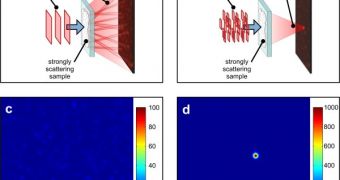This is a utopia turned reality: seeing inside opaque materials. Dutch researchers said that by making wavefronts that invert the diffusion of light, they can focus coherent light through opaque scattering materials. This could significantly improve spectroscopy in scattering media and metamaterials. "Light propagation in opaque materials such as biological tissue is dominated by diffusion," co-author Ivo Vellekoop of the MESA Research Institute at the University of Twente in Enschede told optics.org. "Since diffuse light has no preferential direction, it seems impossible to directionally transmit light through a multiple scattering material."
Vellekoop and his colleague, Allard Mosk, found that the solution was in changing the incident wavefront of the laser beam. The incident light is shifted in such a way that the scattered light interferes creating a sharp focus after it has crossed the opaque material.
The researchers began by illuminating the sample with a focused plane wave. Behind the sample, there is a random complex of constructive and destructive interference forming a small signal with a speckle pattern. "We divide the incident wavefront into segments and cycle the phase of each segment. This allows us to find the phase at which the light from this segment interferes constructively with the small initial background signal. Once we know the optimal phase for each segment, we program a phase modulator with the optimal incident wavefront and a single bright focus appears behind the sample." explained Vellekoop.
The phase-altering algorithm worked perfectly on titanium-dioxide pigment, daisy petals, eggshell and a human baby tooth, with a thicknesses going from 10 microns to 1.5 mm. "The algorithm creates a spot that is up to 1000 times brighter that a normal diffuse transmission spot. The algorithm is fully automatic and performs a measurement for each segment and constructs the optimal wavefront. The time required to construct the wavefront depends on the number of segments. A contrast of 10 can be achieved in a matter of seconds, while a contrast of 1000 takes over 15 minutes," said Vellekoop.
New materials are tested, like porous gallium phoshide. "We are starting work on wavefront optimization using local nanoscale probes which can be put inside tissue. We are also investigating real time wavefront construction.", Vellekoop explained.

 14 DAY TRIAL //
14 DAY TRIAL //